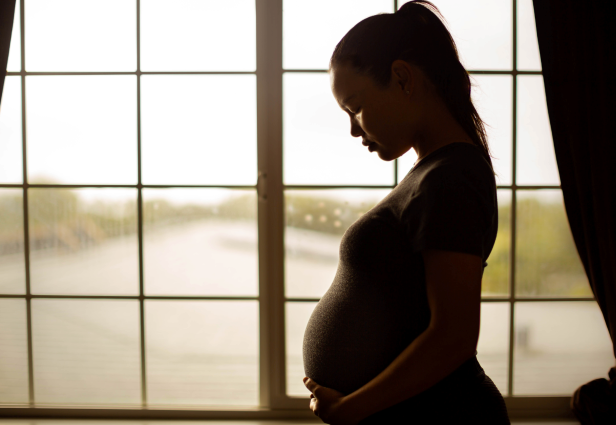
For labour to result in a spontaneous vaginal birth we need a uterus to contract effectively. This causes the cervix to soften and thin and then to be drawn up into its lower third, leaving space to push a baby through.
Unless you are one of a small percentage of women who say they don’t feel those contractions as pain, we need some strategies to help work with the sensations that get stronger throughout the first stage of labour as the cervix dilates, pressure on organs increases and the baby moves deep into the pelvis.
Preparation for labour starts in pregnancy. As soon as you start telling people your good news, they will gleefully share their disastrous birth story, or their friend’s, or their neighbour’s, maybe all three! If you were concerned before, now you’re terrified. This fear is very unhelpful during birth.
Perhaps you have laboured before? How was that birth? Did anything happen that you have lingering questions over? Are you worried about going through labour again? This anxiety won’t work in your favour. Ensure you talk through your previous experiences with your midwife to clear up any concerns you may have so you can look at this labour from a calm, healed perspective.
Our brain is such a powerful tool, we need it working with us, not against. There are many natural approaches to childbirth, for example Lamaze technique, the Bradley method and Hypnobirthing, that are useful options, and I also think having an idea of how our hormones can help or hinder is beneficial. So, what can someone who is fearful of their upcoming labour do?
Talk it out
Share your thoughts with your partner, midwife or childbirth educator (CBE). Find a positive birth ally who you can confide in but who isn’t going to perpetuate your fears. If you would like to read other people’s positive birth stories for a change, visit www.tellmeagoodbirthstory.com for first-hand powerful birth experiences, or listen to a podcast such as Kiwi Birth Tales (episodes 46 and 49 for instance), and there are many more great episodes.
I wouldn’t advise watching a birth that you didn’t know was a positive outcome beforehand. Steer clear of TV series that show multiple scenarios in one show, they won’t all be awesome labour/births as they need sensational television to fascinate the audience, and normal labour is often quiet and still and done in the dark, so not good TV!
Put positive thoughts in your head
Find yourself a little mantra that ‘talks to you’. You can use this during a meditation, at the end of a yoga session, or just in a quiet time at the end of each day – a moment of mindfulness. I did a search of the internet and quickly found several that I liked … my body was designed to do this … breathe in strength, breathe out tension … my body is working for me …
Get prepared
Prepare for the labour you hope to achieve and prepare your partner and other birth companions too. This will help reduce anxiety on the day as you know they know things such as where to park if you’re going to a hospital or birth centre because you did a tour. They helped you pack the hospital bag, so know where to find the wheat pack. You have been using some massage techniques during pregnancy that can be great pain relief in labour. They have joined you at antenatal classes to learn with you how best to help, not hinder the process.
Did you know that having positive, loving support during labour really helps enhance the hormone oxytocin that works to contract the uterus? If you are stressed, you release hormones that can slow down labour, which is cruel, I think, because if you are worried that labour might be long and painful it can become a self-fulfilling prophecy.
Think of labour and oxytocin like a burning fire that needs regular stoking, and the stress hormones cortisol and adrenaline are like buckets of water that would put out the fire. What enhances oxytocin production and stokes that fire? This precious hormone is the hormone of LOVE, LABOUR and LACTATION. It is there when we feel loved; hugging someone you love is a great start. If this person is your partner, actually making love and having an orgasm produces loads. So it makes sense that we need it again in order to produce the child too.
In his blog, 10 unusual ways to release oxytocin, James Altucher calls oxytocin the “life hormone”, there for critical moments of life creation. Basically, we produce oxytocin when we feel good, so feeling loved, laughing, being connected to others, even over social media, listening to your favourite tunes and eating yummy food will all help. Deep breathing, always recommended in labour to help you “relax, release and let go”, is another that helps release more oxytocin, and tells your brain that you are safe, therefore you can birth where you are. It also takes more oxygen to that cramping uterus, so no bad news there!
Prepare the birth environment
It could be your home, a birthing centre or a hospital, all of these can be set up to be birth-friendly. Again, this is about your brain more than anything else. A woman who feels safe and calm will be able to relax into the process. Her own natural pain relief in the form of endorphins are flowing. Safety is in the eye of the beholder though, so while one woman might feel safe in hospital with all the “bells and whistles”, another woman may feel safest at home, where everything is familiar. A midwife is present for safety too, two midwives are there when baby arrives, again for safety.
Another important factor is privacy. It is stressful to think you are baring your body, or strangers may come into the room, so to have a private space helps her not feel on display and that whoever’s in the room is familiar to her. The door is closed and remains so. The lights are dim too. The air is warm, soft music is playing in the background. I joke in my classes that if you removed the midwife and looked at the room and asked the question, “Could we make love here?” if the answer is yes, then it’s conducive to birth.
If your plan is for a normal physiological birth, use your most powerful ally, YOU!
Find out more
- Dick-Read, G. (1959) Childbirth without Fear: The Principles and Practice of Natural Childbirth
- Lothian, J. A. (2004). Do Not Disturb, the importance of privacy in labour. The Journal of Perinatal Education.
- www.lamaze.org
- www.bradleybirth.com
- www.positivebirths.co.nz
- www.childbirthconnection.org






